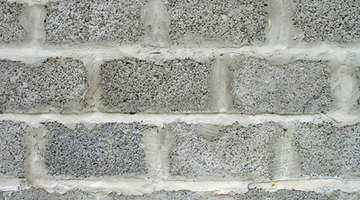Cinder Block Wall Problems
Table of Contents
Cinder blocks, also commonly called cement blocks, are traditionally used to construct building foundations and walls. The rectangular, rough finish blocks with open centers are generally preferred for their strength, versatility, light weight and affordability.

However, like most wall building materials, cinder block walls can develop problems related to freezing weather cycles, extreme amounts of rainfall, pressure from nearby concrete structures and heavy vehicle traffic.
Cracks
Although more common in the mortar than in the cinder blocks themselves, cracks are normally caused by shifts in the concrete footing on which the wall is built, pressure from underground water or saturated soil, or heavy vehicles or equipment that cause extreme vibrations in the structure when operated nearby. A vertical crack that is fairly consistent in width and has a wall on one side that is taller than the other is usually due to an unstable footing. If the crack is erratically shaped, the footing was likely installed over bedrock, a boulder or poorly compacted fill that make the wall sag on one or both sides.
Tipped Walls
If a cinder block wall is leaning or tipping to one side, the aforementioned circumstances that cause cracks are probably the root of the problem. In areas that experience extremely cold temperatures, repeated heavy frosts can break down the concrete footings and make the wall lean.
Buckling and Bulging
Cinder block walls that develop bulges and buckles in various spots are commonly part of a basement or cellar that has another structure atop it that is too heavy for the wall to bear. The bending of the wall may also be caused by the weight of earth or accumulated water above it.
Shear Failure
If cinder block walls appear to be horizontally sliding over top of lower wall portions, the problem is often attributed to the lack of vertical steel reinforcements in the structure. This is called shear failure. The protruding blocks may be at the top of the wall or further down and are most common in walls that are solely secured by an underlying concrete slab.
Solutions
Once a cinder block wall has exhibited physical abnormalities, it is usually beyond repair. Although exterior steel reinforcements may delay further deterioration, the wall will eventually fail and have to be replaced, a difficult and costly task that requires jacking up or securing the surrounding ceilings and walls. To prevent future cinder block wall failure, building contractors usually recommend using vertical steel reinforcements in the construction and contracting the job with a licensed masonry professional.
The Drip Cap
- Cinder blocks, also commonly called cement blocks, are traditionally used to construct building foundations and walls.
- This is called shear failure.
- Although exterior steel reinforcements may delay further deterioration, the wall will eventually fail and have to be replaced, a difficult and costly task that requires jacking up or securing the surrounding ceilings and walls.
References
Writer Bio
Cassie Damewood has been a writer and editor since 1985. She writes about food and cooking for various websites, including My Great Recipes, and serves as the copy editor for "Food Loves Beer" magazine. Damewood completed a Bachelor of Arts in English with an emphasis in creative writing at Miami University.
Photo Credits
- block wall image by Irina Kodentseva from Fotolia.com
- block wall image by Irina Kodentseva from Fotolia.com
More Articles



